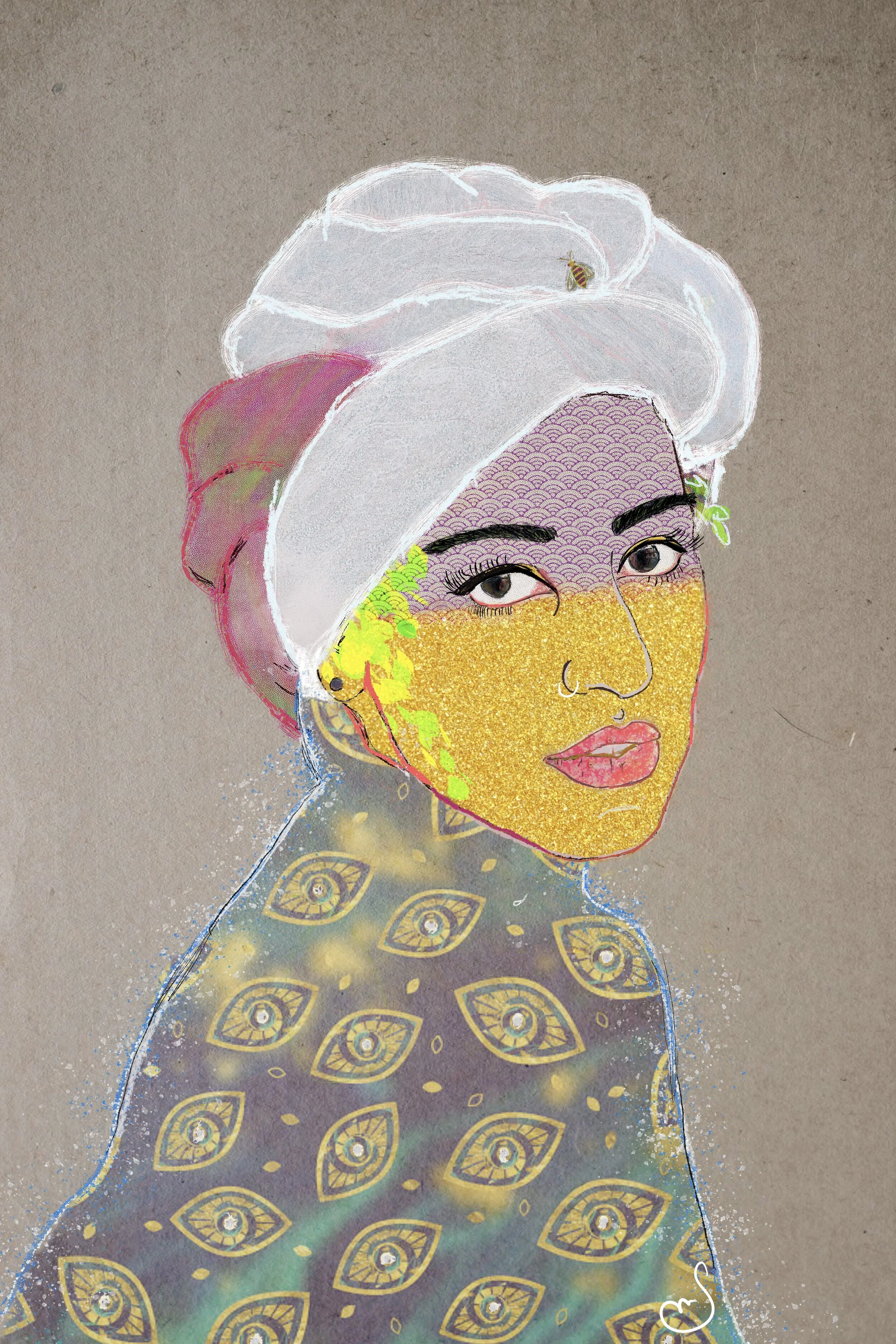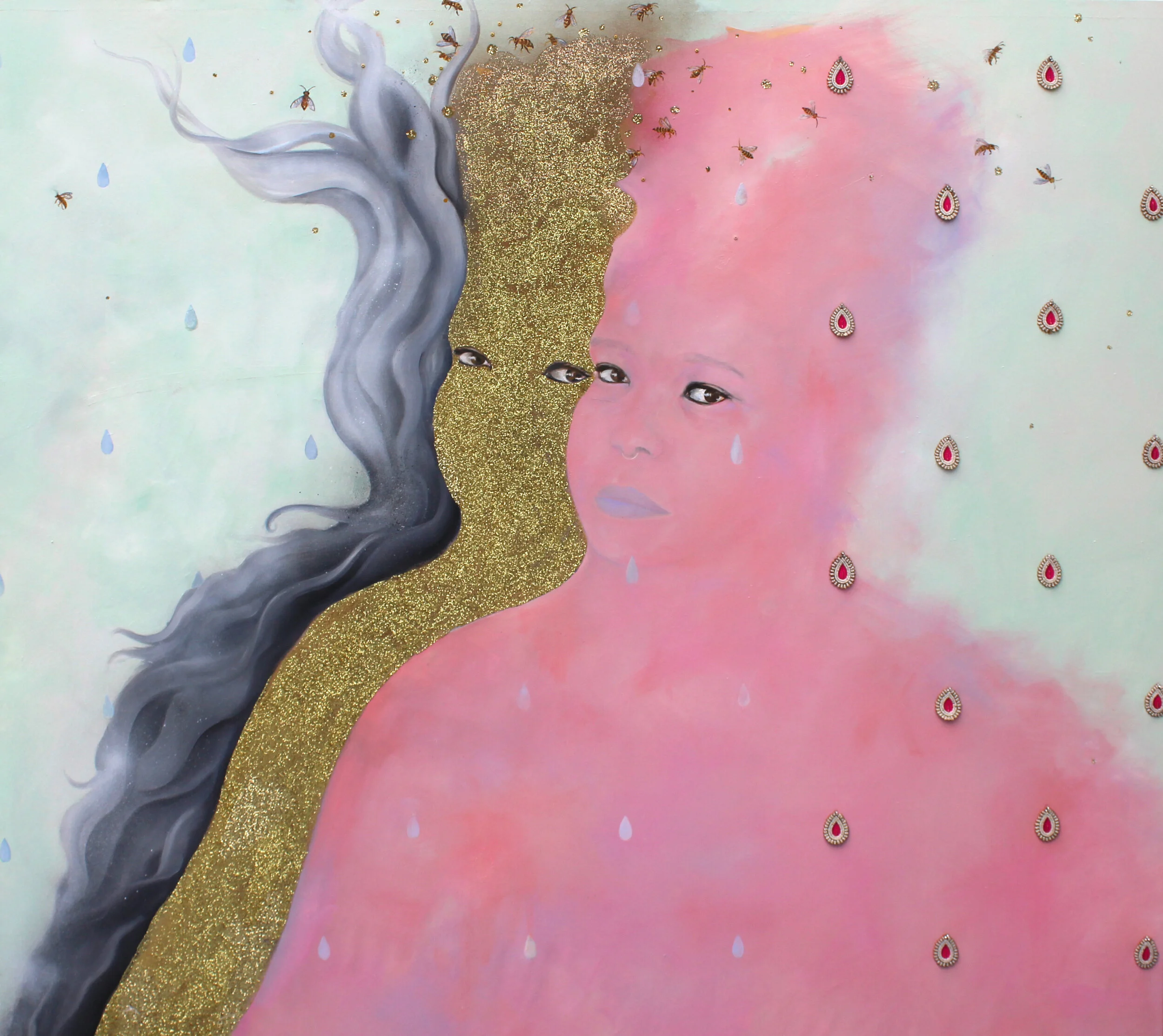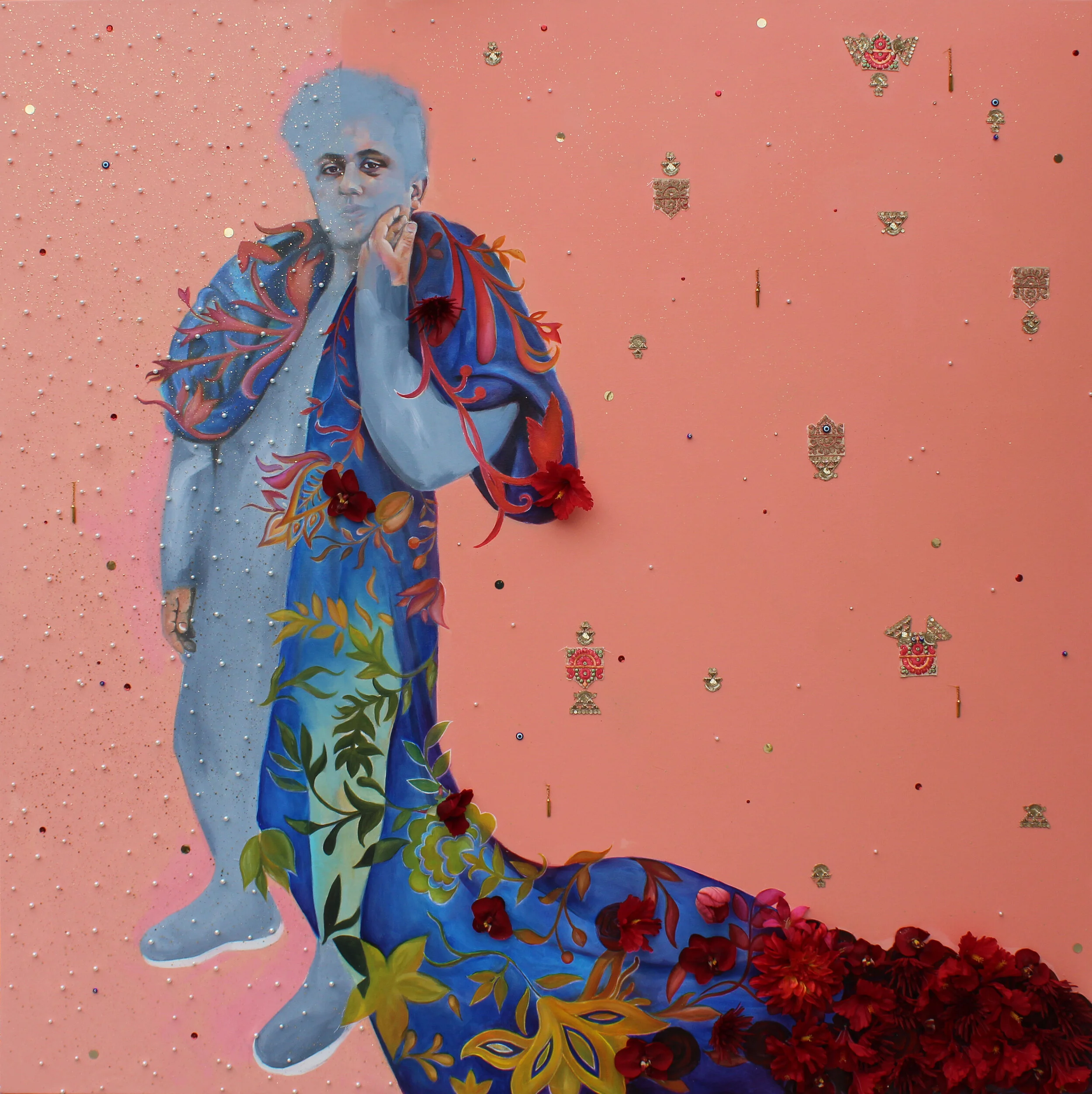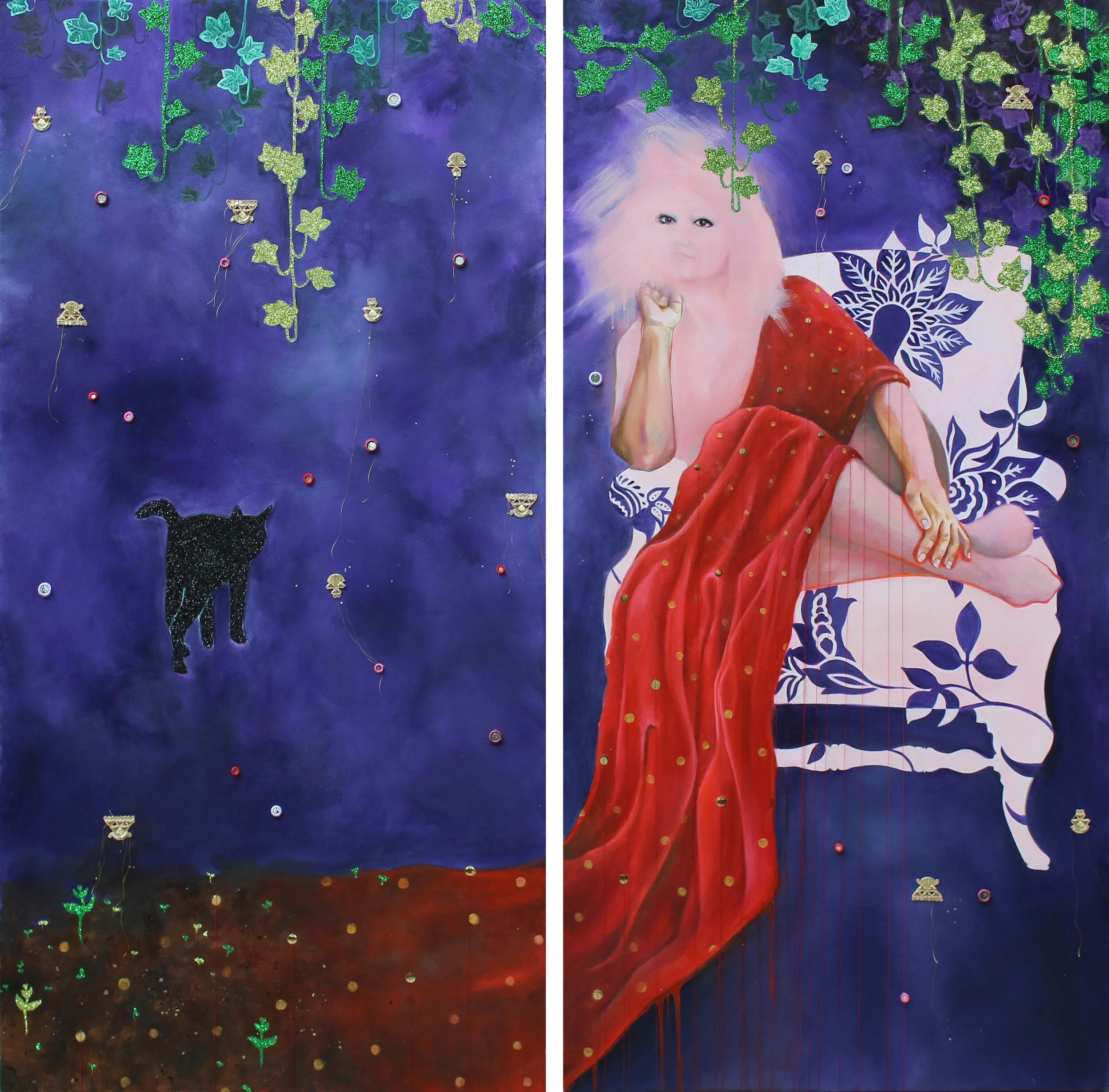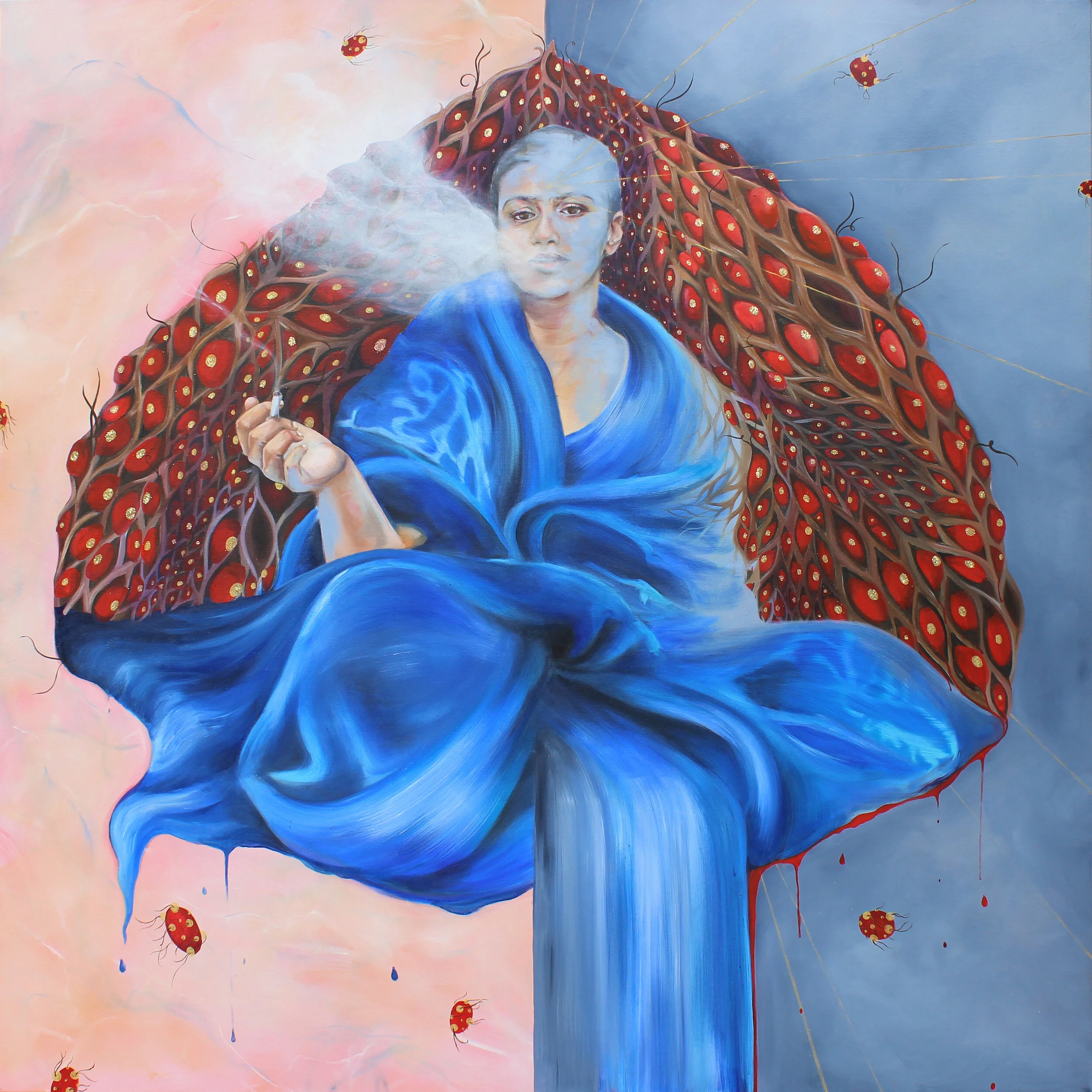Saba Taj
Illustration by Sed Miles
Saba Taj is an activist and interdisciplinary artist known for her apocalyptic mixed media works. Through artistic advocacy, Saba centers queer identities and challenges, simultaneously dismantling homophobia and Islamophobia in her representations of power and revolution.
What influences your choice of mediums? How is your process of creating reflective of the creation?
I’m South Asian, and our aesthetic is maximalist af.
Liminal Being(s)
oil paint, glitter, appliques, gold leaf, spray paint on canvas
I suspect that’s part of why I love sparkly things and layering. I also love using cheap stuff—glitter, faux flowers, plastic beads—in ways that feel really decadent. Honestly, I just use whatever I am attracted to and works with the artwork. I maintain a broad vocabulary of materials and processes that I can use. I wish I could do all the things at once.
With my collage works, there was particular meaning in the materials and processes. I cut up magazines that were full of images that shape and reflect problematic, widespread definitions of beauty and of value. I used US American and South Asian beauty magazines, and also National Geographic, which has historically been full of examples of the white gaze on Black and brown peoples/cultures. It was meaningful to cut up those images and figures and recombine them. The process reminded me of revolution, or apocalypse. Destruction and rebuilding. And the figures, created from all these different fragments, were monstrous and hybrid, existing in a sort of surrealist, post-apocalyptic future.
An objective of yours has been to “humanize” certain groups. What does that mean?
I’ll admit that it’s been a while since I’ve used this term “humanize” because it implies that we must be made human, that we are beginning from a lack of humanness. In my work, I include imagery that directly or metaphorically represents my people, and I depict them empowered, triumphant, and in their dignity.
Babyking
oil paint, acrylic paint, silk flowers, organza, plastic pearls, glitter, sequins, beads, rhinestones, tassels, trims on canvas
Dehumanization of certain groups is a tool of supremacy that serves to make violence and systemic oppression against those groups more palatable to the masses. Dehumanization often manifests as making some into society’s monsters—either fearsome and presumed a threat to the social order, or conversely, victims in need of saving. I think the only way to return to our collective humanity is by toppling all those supremacies. That’s work that art can be a part of, but a painting cannot do that work alone.
In my collage works, I actually depict monsters—hybrid creatures who inherit the earth after an apocalypse.
In these works, I am making no attempt to humanize, but instead am embracing monstrosity to subvert this idea that we are monstrous. Antoine Williams is a North Carolina artist whose work is in conversation with Monster Theory, and as a Black man, he speaks directly to racist mythologies like that of the “super predator.”
So, to “humanize” certain groups, would mean I am convincing those who question our humanity that I am and we are as human as they are. And I don’t really have any interest in catering my work to those folks anymore, but I feel like I’m doing something right when my people can see something of themselves reflected in the work I’ve done.
What is resistance art, and how is art sometimes activism?
I think that for marginalized folks, creating is in itself an act of resistance and resilience. And I consider many expressions of activism to be art, as well. I hesitate to make clear shapes around these ideas, because art and resistance are fluid and shape shifting and all around us.
We love your latest series work For My People at the Threshold
Springtime in Barzakh
Oil paint, glitter, mica flake, thread, sequins, trims, shisha embroidery on canvas
What else can we expect to see in this series?
Thank you! I’m working on at least four more pieces for this project, but I’m still feeling quite inspired by it, so might continue beyond that. Due to the limits on travel, the majority of the subjects are folks in and around Durham, which is actually quite special. In this series I am thinking a lot about liminality and queerness, and have been studying barzakh in Islam and Sufi philosophy. In the teaching of Islam, barzakh is where our souls reside after death but before the Day of Judgment. It is essentially an in-between space, the location between two binaries (life and death, Heaven and Hell, physical and spiritual). I’m interested in this location as a concept.
Marginalization is made possible through the construction of borders and binaries between and within our bodies and identities. I find that queerness regularly and ferociously disrupts these borders and binaries, and by doing so, creates space for more authentic ways of being in our individual and collective bodies. There’s a freedom in that space. So in these portraits, I reference these ideas in a number of different ways. I consider this project to be surrealist documentary, existing in that space between realism and magic.
What does “My People” mean?
In the arts and beyond, there is a tendency to default to and cater to white audiences, no matter what the topic of conversation. That’s white supremacy. I make art for my people, for me, for who I am accountable to. It felt important to state so explicitly here. My people are the folks I fight for and who fight beside me. My people are people of color, are queer and trans, are Muslim. It matters who makes the work, and about whom. That relationship between the maker and the subject is of great consequence, and essential to the ethics I employ in portraiture. This series feels like a love letter to my people, and I want that to be centered. I don’t make art to educate or convince white people of anything. It’s tough because the white gaze is unavoidable, which means that regardless of my intentions, my work is often received through a filter of whiteness, heteronormativity, orthodoxy.
Most of your art is surreal or dreamlike. What inspires you to create these kind of scenes?
At the Meeting of the Seas
Oil paint and glitter on canvas
Probably Sunday School [laughter]. I’m more influenced by Islamic stories, from the Quran and Hadith (stories of the Prophet Muhammad’s life), Octavia Butler, and like, X-Men.
I learned about all these magical Islamic stories, and they were part of our truth. Literal miracles and flying creatures. It’s so sci-fi. I just love this stuff. And I think these stories, and surrealism and magic in general, are vehicles for us to imagine the future in radically new ways. I need magic in my truths. Objectivity is the myth.
In your Borders/Portal painting, a figure enters what looks like a window to space. What was your thought process here?
Borders/Portals (Are So Gay)
Acrylic paint, oil paint, spray paint, gold leaf, glitter
This is another reference to barzakh. It is sometimes described as a “veil between worlds,” and a doorway or window functions similarly. They are stepping into this threshold, beyond which are all kinds of possibilities.
What does success look like for you?
Today, I would describe success as remaining soft to transformation and growth, a commitment to being in right relationship with my people, and being present for pleasure.
Original Saba Taj works are available for purchase here, and Elder Gallery, Charlotte

